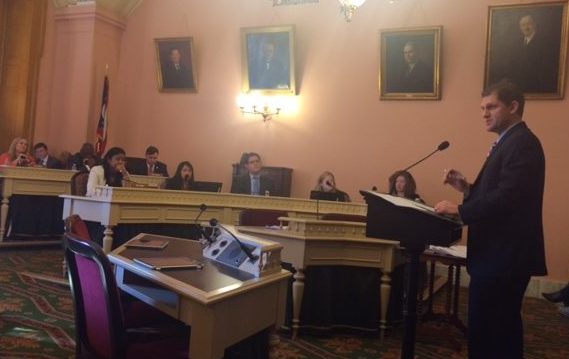
Matt Szollosi, ACT Ohio Executive Director, testifies before the committee.
Matt Szollosi, ACT Ohio Executive Director, testified on Tuesday in the Ohio House of Representatives in opposition to House Bill 394. In its current form, the bill aims to eliminate a $775 million dollar deficit and create a solvent unemployment trust fund balance, but fails to take into account several provisions that would be harmful to the construction industry.
Szollosi outlined these potentially damaging effects in his testimony, beginning with benefit eligibility. As proposed, HB 394 would reduce the number of weeks which a claimant can receive unemployment benefits, from 26 weeks to as low as 12 weeks, depending on the overall unemployment rate. This is particularly troubling to the construction industry because during times of economic downturn, the construction industry is hit disproportionately harder than other industries. Szollosi remarked that from 2008-2014 the national unemployment rate reached 10% in only one month whereas during the same time period the construction industry unemployment rate exceeded 10% in 60 months.
In addition, Szollosi also provided graphs with statistics showing that, the industry takes longer than other sectors to recover. For example, said Szollosi, although the national unemployment rate peaked at 10% in October, 2009, the separately-kept Department of Labor Bureau of Labor Statistics construction industry unemployment rate over the same period of time shows that unemployment in the construction industry remained over 10% for an additional 47 months! Therefore, Szollosi said, conditioning construction workers’ benefits on the unemployment rate would be “catastrophic” for the industry resulting in an exodus of workers at a time when the primary concern of contractors and investors is the availability of a qualified, skilled workforce.
Szollosi then pointed to the bill’s requirement for earnings in at least three quarters of the claimant’s benefit year as having a disproportionately harmful impact on construction workers and families. Given the variables that impact the construction industry such as weather, capital improvement spending, time of year, and bid results, it is not uncommon for construction workers to be off for six months or more in Ohio. He then noted that if HB 394 became law as currently drafted, many workers would be denied future benefits through no fault of their own.
The last portion of his testimony centered on the additional waiting week that would be implemented. Currently, a jobless individual waits a single week per year before they are eligible for unemployment benefits. Under the bill, there would be an extra waiting week to claimants every time earnings exceeded their individual weekly benefits. Szollosi explained that many short term jobs arise, some lasting only a few days. If this waiting week provision was implemented, those taking the short calls would have to wait an additional week to receive benefits if their earnings for the call exceed their weekly benefit amount. Szollosi explained this effectively penalizes workers for taking short calls, and as such, referral halls would have a much harder time filling short calls to meet the demands of the contractors and customers.
In addition to today’s testimony, Szollosi has had very productive dialogue with the bill sponsor, Rep. Barbara Sears, the Speaker Pro Tem Ron Amstutz, and Speaker of the House Cliff Rosenberger. ACT Ohio will keep its affiliates informed about this legislation’s progression.


